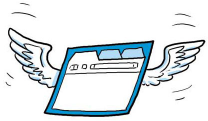
After making the chromes shine on Ubuntu, let’s make them flashy! In the previous article you learned how to have Google Chrome and Chromium installed, now that you have used them for awhile, you perhaps find out that you cannot play video on youtube.com or dailymotion.com, that you do not have annoying advertisement, etc. Yes, Google Chrome and Chromium Linux versions do not yet support Adobe Flash!
However, since you are not afraid to try a test version of these browsers on your favorite OS, you will not mind activating a test feature: plug-ins.
Now you probably have already installed Flash plug-in for Firefox? If you haven’t done yet is here how to do it. You have to install the Flash plug-in package. This package is available with the “Add/Remove Applications” (directly accessible under your Applications menu), simply type “flash plugin” in the search box and scroll down a bit to find the entry, you can either choose “Macromedia Flash plugin” (recommended) or “Adobe Flash Plugin”, both are version 10 of Flash.
Now you need to open a terminal (Applications -> Accessories -> Terminal) and type the following commands (check that you have read the conventions before proceeding).
$ sudo updatedb
$ locate libflashplayer.so
Check the output it should be on Ubuntu 9.04 either /usr/lib/adobe-flashplugin/libflashplayer.so or /usr/lib/flashplugin-installer/libflashplayer.so. Now you only need to create a shortcut in Chromium plug-ins directory to one of these files. the following line is an example, replace the correct path by the one given in output of the previous command:
$ cd /usr/lib/chromium-browser/plugins/
$ sudo ln -s /usr/lib/flashplugin-installer/libflashplayer.so
Note: Both Chromium and Google Chrome seem to use the same plug-ins directory.
Now, you have installed the plug-in, it will be automatically updated when a new version is available in the repositories, this is because we made a shortcut (a link) instead of duplicating the file (a copy).
It is now time to enable plug-ins (a testing feature) in Chromium and Google Chrome. Just add ‘–enable-plugins’ to the command line when calling chromium or google-chrome. Example:
$ chromium-browser --enable-plugins
You can update your icons in the menu bar by right clicking on them, choose “Properties” and in the command field write (without the double quote): “chromium-browser –enable-plugins %U” (for Chromium) or “/opt/google/chrome/google-chrome –enable-plugins %U” (for Google Chrome). Proceed in the same manner for your icons in the Applications menu, but you will have to use the menu editor located in System -> Preferences -> Main Menu.
Now, restart your browser and go enjoy this nice music clip: Playing for change – Don’t worry!
PS: you do not want the Flash plug-in (it is not free/libre) and the flashy advertisement bothering you, but still you would enjoy watching some streaming video? Well, then check the OpenVideo effort from Dailymotion, no Flash, just plain HTML5, compatible with Chrome/Chromium/Firefox! Here is a fine example: 36th below, animation movie (French).
Updated ’09-09-05: both Chromium and Chrome seem to now look in the Mozilla plug-ins directories for available plug-ins. It is no longer necessary to copy/link individual plug-in – like Adobe Flash player – in the Chromium directory. Hence, the part removed in this article. I will explain in a next article to come, how to have a 64bit Flash player for those out there having a 64bit OS!

